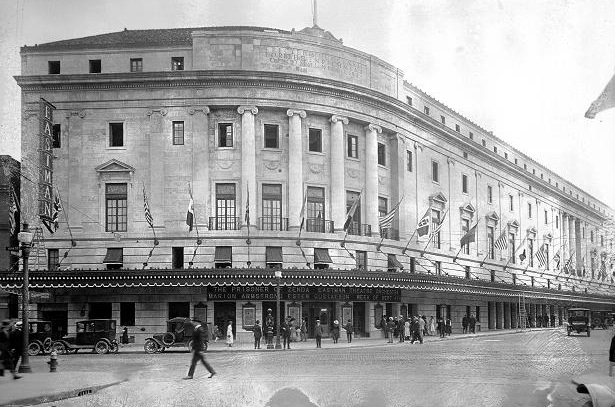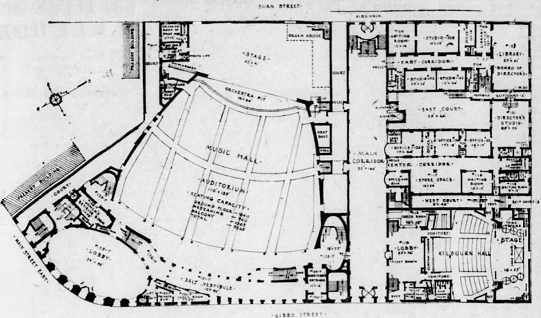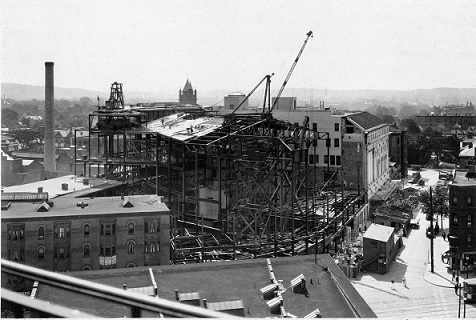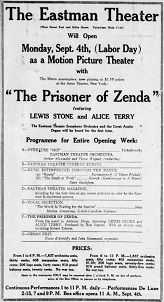
| Eastman School of Music | Eastman Theatre |
 |
| Eastman Theatre in 1922, from Rochester
Public Library |
 |
 |
 |
| "Plan of Great Building that George Eastman Is to Erect," Democrat and Chronicle, February 25, 1920, Page 21. | Eastman Theatre under construction, September 13, 1921 | Opening Week Program, Democrat and Chronicle, September 3, 1922, Page 22. |
Ground was broken for he new School of Music building at the beginning of 1920 and after a tumultuous period of construction it opened its doors to students on September 12, 1921. The Eastman Theatre opened a year later and has been renovated several times.
Air conditioning was added to the theatre in 1929, following similar installations at other venues in Rochester.
References
1920 "Plan of Great
Building that George Eastman Is to Erect," Democrat and
Chronicle, February 25, 1920, Page 21.
1920 "Because
of High Costs and Uncertainty as to Future Eastman Suspends Building,"
Democrat and Chronicle, March 19, 1920, Page 28.
Decision affects School of Music.
1921 "Framework of Eastman Theater nearly finished," Democrat and Chronicle, September 26, 1921, Page 15.
1922 "Reserved
Seat Problem Solved by Mezzanine," Democrat and Chronicle,
July 17, 1922, Page 12
New Eastman Theater Will Have Ideal Arrangement of Its Patrons.
1922 "Lest
Trains Delay, Truck Bring Theater Material Here," Democrat and
Chronicle, August 15, 1922, Page 15.
Dimmer Bank for Lights in Eastman Theater Comes Overland by Motor.
The trip from Mount Vernon was made in exactly forty-nine hours and
fifteen minutes.
1922 "Great
Chandelier at New Eastman Theater Is in Place," Democrat and
Chronicle, August 22, 1922, Page 16.
The fixture consumers about fifty horsepower of energy.
1922 "Console for Eastman Theater Organ Being Connected to Speaking Pipes," Democrat and Chronicle, August 24, 1922, Page 16.
1922 "The
Eastman Theater Will Open Monday, Sept. 4th, (Labor Day) as a Motion
Picture Theater," Democrat and Chronicle, September 3, 1922,
Page 22.
Program for entire opening week.
1922 "Electricity in the World's Finest Movie - Rochester's New $5,000,000 Eastman Theatre," Electrical Merchandising 28(4):81-82 (October 1922)
1923 "The Electrical and Illuminating Equipment of the Eastman Theatre and School of Music," by Frederick A. Mott and Loyd A. Jones, Journal of the American Institute of Electrical Engineers 42(6):569-582 (June 1923)
[1923] The Austin organ in the Eastman Theatre, Rochester, N.Y.: the largest theatre organ ever built, Austin Organ Company
1923 A List of Organs Installed and Under Construction by Austin Organ Company
1925 "Acoustics of the Eastman Theatre, Rochester, N.Y.," by F.R. Watson, The American Architect 128(2475):31-34 (July 1925)
1926 Plat
Book of the City of Rochester
Plate
2: Eastman School and Theatre
1927 "Eastman
Theater Issues Booklet," Democrat and Chronicle, March 1,
1927, Page 24.
Building and Music School Pictures and Described.
1927 Rochester,
the making of a university, by Jesse Leonard Rosenberger, with
an introduction by President Rush Rhees.
Page 302-316: Eastman School of Music
1935 Plat
Book of the City of Rochester
Plate
1: Eastman School and Theatre
1937 Carrier
Centrifugal Refrigeration
Eastman Theater, Rochester, New York, installed 1929, 164 tons
1954 "Eastman
Theater Ceiling Falls," Democrat and Chronicle, December 10,
1954, Page 1.
4 Huge Panels Tumble from Arched Dome at 4:45 pm yesterday
1955 "Eastman Ceiling Hangers Tested," Democrat and Chronicle, January 13, 1955, Page 19.
1955 "Eastman
Ceiling Repairs To Cost U. of R. $100,000," Democrat and
Chronicle, February 5, 1955, Page 14.
Investigators suspect that installation of sheet metal work for air
conditioning 25 years ago near the trouble sot caused a gradual
weakening. The sheet metal has since been removed.
1955 "Better
Than New," Democrat and Chronicle, April 6, 1955, Page 19.
Eastman Theater ceiling reinforcement. Ceiling fell Dec. 19.
1977 History
of the University of Rochester, 1850-1962, by Arthur J.
May. Expanded edition with notes
Chapter 18, The Birth of a Music Center
Seven months later, on Labor Day, September 4, 1922, the magnificent
Eastman Theatre, not quite completed, welcomed movie patrons for the first
time. They saw a film, "The Prisoner of Zenda," listened to the theatre
orchestra and vocal selections, and watched a ballet performance.
Admission fees ranged from twenty cents to one dollar.
Starting in 1922 and continuing for nearly four decades, the Rochester
Federation of Churches conducted its annual Thanksgiving Day service in
the Theatre; it was also used for big civic and community gatherings and
for the graduation exercises of Rochester high schools. Similarly, from
1923 onward for thirty years, University Commencement ceremonies were
staged in the Theatre, and it was the setting for occasional
all-University convocations and for the installation of three University
presidents.
The walls of the spacious, gracious, oval-shaped lobby of the Theatre were
finished in Botticino marble, interrupted by six black marble columns and
doorways leading to the auditorium. Half a dozen mural paintings decorated
the lobby, one a copy of "The Reconciliation of Venus and Psyche,"
commissioned originally by Napoleon I. Travertine stone, imported from
Italy, covered the floor, on which were placed seats of carved marble and
a matching table. Two circular panels adorned the slightly domed ceiling,
and two chased bronze tripods and electrical fixtures attached to wall
pilasters supplied light. An ample foyer led into the, majestically
proportioned auditorium, which could accommodate 3,352 patrons--l,848 on
the first level, over 400 in the mezzanine gallery (Eastman reserved seats
for himself and his personal guests here), and nearly one thousand in the
grand or upper balcony. To the rear of mezzanine and balcony, extensive
foyers were provided, along with smoking, powder and cloak rooms. An
elegant stairway gave access from a west side foyer off the main floor to
the promenade corridor above.
Throughout the Theatre comfortable upholstered seats were installed; no
boxes or posts prevented a full view of the stage, and acoustic and
ventilation arrangements were as perfect as scientific ingenuity could
make them.
To enhance the charm of the vast auditorium, the walls were embellished
with eight mural paintings, depicting ensembles of figures symbolizing the
varied types of music set against backgrounds of Italian landscape. Four
colorful panels on the left wall looking toward the stage represented
festival, lyric, martial, and sylvan music--the handwork of Ezra Winter,
an artist of national renown, who had general supervision over the color
schemes and decorations of the entire music center. On the opposite wall,
paintings by Barry Faulkner, an older and gifted decorator, symbolized
sacred, hunting, pastoral, and dramatic music. Bas reliefs above the
murals, in the form of children and musical instruments, were created by
the sculptor Paul Jennewein, trained at the American Academy in Rome.
Higher up the cornice was decorated with arabesque patterns of harps and
shields, scrolls, and winged sea-horses. For circular niches in the walls
near each side of the stage, a youthful sculptor, Leo Friedlander, created
heroic gilded busts of Ludwig van Beethoven and Johann Sebastian Bach (no
favorite of Eastman's), and portrait medallions set into the balcony rail
recalled fifteen other celebrated composers. The generously ornamented
proscenium arch bore a shield with the legend "U. of R.," supported on
either side by an unusual ornamental figure holding a torch.
Rounding out the wealth of artistic treasures, Maxfield Parrish, whose
fairyland vistas had made him one of the best-loved American artists of
the forepart of the twentieth century, painted "The Interlude," placed at
one end of the grand balcony foyer; Eastman thought the picture was "very
strong, simple, forceful." Close by were a decorative fountain showing a
cherub toying with an alligator, and an allegorical Renaissance painting
by Luca Giordani whose voluptuous feminine figures aroused a good deal of
controversy. It was acquired from the recently dismantled residence of a
New York City banker.
From the coffered, domed ceiling of the Theatre hung a handsome massive
chandelier composed of some 20,000 pieces of crystal, backed, by a gilded
sunburst. Two steel cables, capable of supporting a weight vastly greater
than the two and a half ton fixture, held the chandelier in place, and as
an added safety precaution a heavy chain was installed. Made in Europe
this chandelier supplied most of the illumination, and indirect lighting
at intervals on chairs along aisles enabled patrons to read concert
programs with comparative ease. Shortly before the formal opening, Eastman
ordered that more lights should be installed toward the rear of the upper
balcony. Since there was not enough time to obtain conventional fixtures,
galvanized steel washtubs, skillfully disguised by lavish ornamentation
sprayed with bronze, were hastily fitted with light sockets. Eastman liked
the ingenious improvisation so well that he insisted they should not be
altered--and the washtub chandeliers remained in place.
While the stage was large, it was less spacious than had been envisaged in
the preliminary planning; off from it were sixteen dressing rooms for
performing artists and facilities for one hundred orchestra players. Until
1926 warmth for the entire music center was supplied by a plant on the
east side of Swan Street; thereafter, heat was purchased from the
Rochester Gas and Electric Company. 8
Small wonder, take it all in all, that a contemporary artist spoke of the
Theatre as "the most beautiful, the most dignified, and most tasteful
structure" for music in the United States. It impressed the world famous
Polish pianist, Ignace J. Paderewski, as the finest temple of music in
which he had ever performed.
The Eastman munificence and the facilities it financed elicited applause
from the press and music journals all across North America and to a degree
in Europe. To a bilious critic, however, the whole undertaking, the vision
of transforming the Flower City into an American Milan, was dismissed as
"the world's greatest experiment in attempting to exchange money for
culture."
Experience dictated several minor alterations in the equipment of the
school and theatre, but little was changed without Mr. Eastman's explicit
sanction. Even minute details of the physical plant engaged his attention,
though he seldom intervened in the educational policies and practices of
the school. Installation of penny vending machines for drinking cups in
the school, the substitution of more melodious chimes for curtain calls in
the theatre lobby and school corridors, a refrigeration system to cut down
summer temperatures in the theatre, a storage vault to hold the records of
the school and theatre, and the blueprints of new University buildings
were each approved by him. He even ordered an investigation to ascertain
whether the expense of lighting the grand chandelier in the theatre--the
cost ran to $2.88 an hour--could be reduced.
Chapter 39, The Eastman School--The Postwar Years
Shortly after its acquisition by the School, Cutler Union performed yeoman
emergency service made necessary by a near tragedy--the collapse of part
of the ceiling of the Eastman Theatre and the consequent forced closing of
the Theatre for repairs in the winter of 1954-1955. Late in the afternoon
of December ninth the Eastman School Chorus and Orchestra were rehearsing
on the stage of the Theatre for a performance of the Bach Magnificat.
Following an ominous crackling overhead, a 400-foot section of the ceiling
"appeared to float downward," scattering debris and a cloud of dust over
the empty seats in the orchestra below. Miraculously, only a few were in
the body of the auditorium; had the accident occurred three hours later,
seats would have been filled for a performance of the Philharmonic. Of the
186 panels in the ceiling, only four had crumbled, but those four could
have wrought havoc in a full house. Theories as to the cause varied; one
held that use of a high-pitched Bach trumpet caused a fatal vibration. A
more probable explanation is that the ceiling had been weakened by
installation of sheet metal work for an air conditioning unit some
twenty-five years before.
Repairs were undertaken immediately under supervision of consultants from
the Massachusetts Institute of Technology. Steel I-beams and rods were
installed throughout the vast ceiling, with more than 3,000 steel hangers,
each, capable of carrying a 2,000 lb. load, supporting the panels. When
completed five months later, the ceiling was declared by the consultants
and by the city's bureau of buildings as safe as human ingenuity could
make it.
As part of the property of the School, cost of the repairs were met from
Eastman School reserve funds. The final bill, to Hanson
"staggering--though reasonable," was $58,879, less than half the sum
originally feared, but still a blow to the School's budget, already
stretched by maintenance expenses of newly acquired buildings. An untoward
effect on the entire U. of R. budget was the doubling of premiums paid by
the University for comprehensive liability insurance.
While the Theatre was closed, scheduled performances were held in other
auditoriums throughout the city, many at Cutler. The Theatre was reopened
and rededicated on May 18, 1955, with a performance of the Director's
Merry Mount (first performed at the Metropolitan twenty-one years before),
the composer conducting. A second performance was given the following
evening; on both occasions, a capacity audience attested that public fears
for the safety of the ceiling had been allayed.
1982 "Mr. Eastman's Theatre," by Margaret Bond, Rochester Review 42(4):16-18 (Summer 1980)
1987 "A
History of the Eastman Theatre," by Vinci Lenti, Rochester
History 49(1):1-24 (January 1987)
This city block-bordered by Main Street on the north, Barrett Alley on the
south, Gibbs Street on the west, and Swan Street on the east-underwent a
profound and dramatic change during the years 1919-1922. George Eastman
had selected this site for the new Eastman School of Music and adjoining
Eastman Theatre, and only two buildings were spared demolition. The owner
of the large building at the comer of Main and Swan demanded too high a
purchase price from Eastman. Rather than agreeing to what he considered to
be an exorbitant amount, the mil-lionaire philanthropist ordered his
architects to redesign the plans for the new theater and abandoned his
efforts to acquire the building. It stood there for over forty more years,
cutting a triangular wedge into the side of the theater, and was finally
purchased by the Eastman School of Music and demolished.
1996 "The Eastman School of Music," by Vincent A. Lenti, Rochester History 58(4):1-32 with illus (Fall 1996)
2010 The Eastman Theatre: Fulfilling George Eastman's Dream, by Elizabeth Brayer
© 2021 Morris A. Pierce